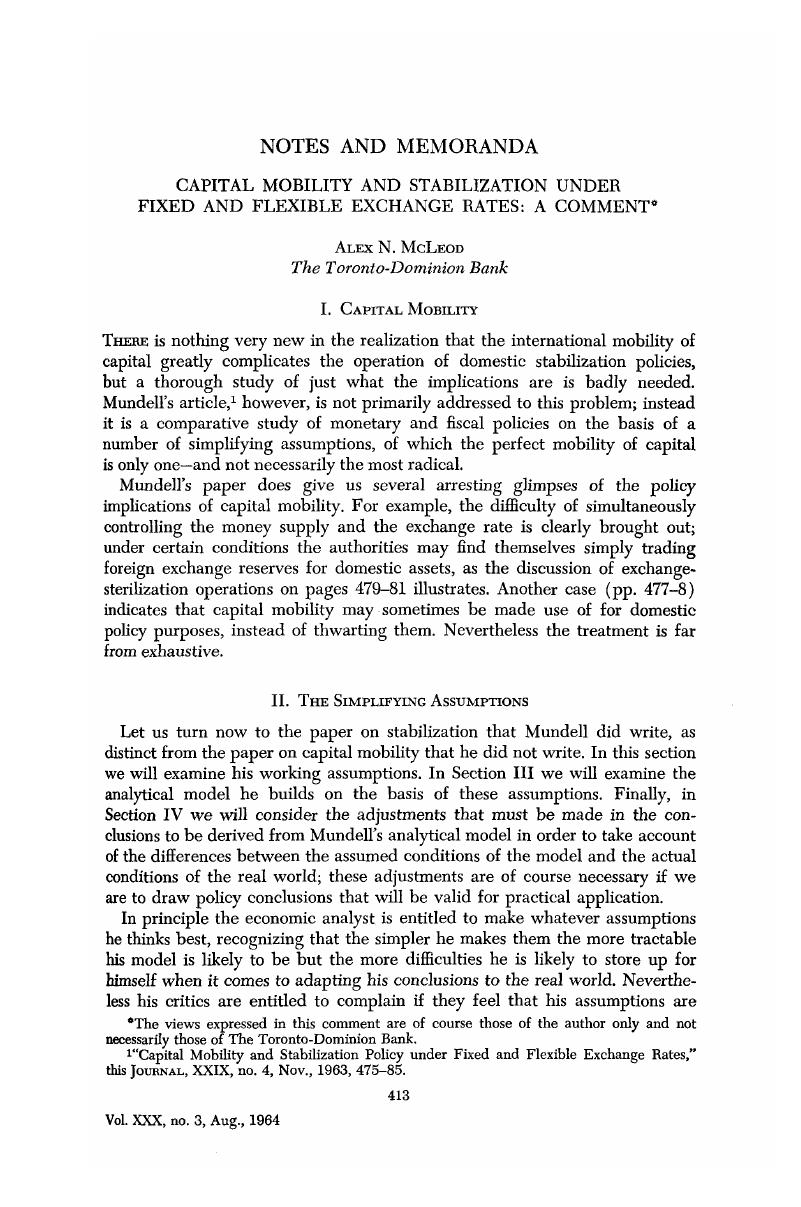Article contents
Capital Mobility and Stabilization under Fixed and Flexible Exchange Rates: A Comment*
Published online by Cambridge University Press: 07 November 2014
Abstract

- Type
- Notes and Memoranda
- Information
- Canadian Journal of Economics and Political Science/Revue canadienne de economiques et science politique , Volume 30 , Issue 3 , August 1964 , pp. 413 - 421
- Copyright
- Copyright © Canadian Political Science Association 1964
Footnotes
The views expressed in this comment are of course those of the author only and not necessarily those of The Toronto-Dominion Bank.
References
1 “Capital Mobility and Stabilization Policy under Fixed and Flexible Exchange Rates,” this Journal, XXIX, no. 4, Nov., 1963, 475–85.
2 Cf. Samuelson, P. A., “Interactions between the Multiplier Analysis and the Principle of Acceleration,” Review of Economic Statistics, XXI, no. 2, 05, 1939.Google Scholar
3 Note that the context clearly shows it to be a definitive relationship, not merely a permissive one. That is to say, it is not merely that at a given rate of interest the public would prefer to hold money in a fixed ratio to income, which would leave open the possibility that a modification in the preferred ratio might be accepted under certain conditions; the public evidently insists on holding money in this fixed ratio, and if necessary will alter its spending pattern in order to restore it.
4 There seems to be some confusion in terminology in this respect. Mundell speaks of central bank open market operations, but the context implies that what is meant is the acquisition of existing securities from the general public by the banking system as a whole.
5 It may be suggested that foreigners may be induced to sell securities in exchange for domestic money. However, this will not do either. As indicated in a footnote to Table I, foreign holdings of domestic money are negligible; and even if this point is waived any increase in money balances held by foreigners would contravene the assumption that the money supply is determined solely by income and the rate of interest.
6 If a lower exchange rate is appropriate under a fluctuating rate system, why not alter the rate directly by intervention in the exchange market instead of indirectly by monetary expansion? The same thing can, of course, be achieved equally effectively under a fixed rate system by an overt devaluation.
7 Implicitly or explicitly it is included in the various “multiplier” computations, going back at least to a version of the foreign trade multiplier developed in 1928 by the Australian Development and Migration Commission, as reported by Copeland, D. V. in Australia in World Crisis, 1929–1339 (New York, Cambridge, 1934), 12.Google Scholar
8 Theoretical treatments of the “foreign drain” tend to be in terms of increased import demand, but the importance of autonomous capital movements has long been recognized also, as is implicit, for example, in any discussion of a capital flight.
9 Even if future experience proves that interest differentials will tend to disappear when net flows become negligible, it may be found that they will reappear in opposition to substantial net flows in either direction.
- 3
- Cited by


